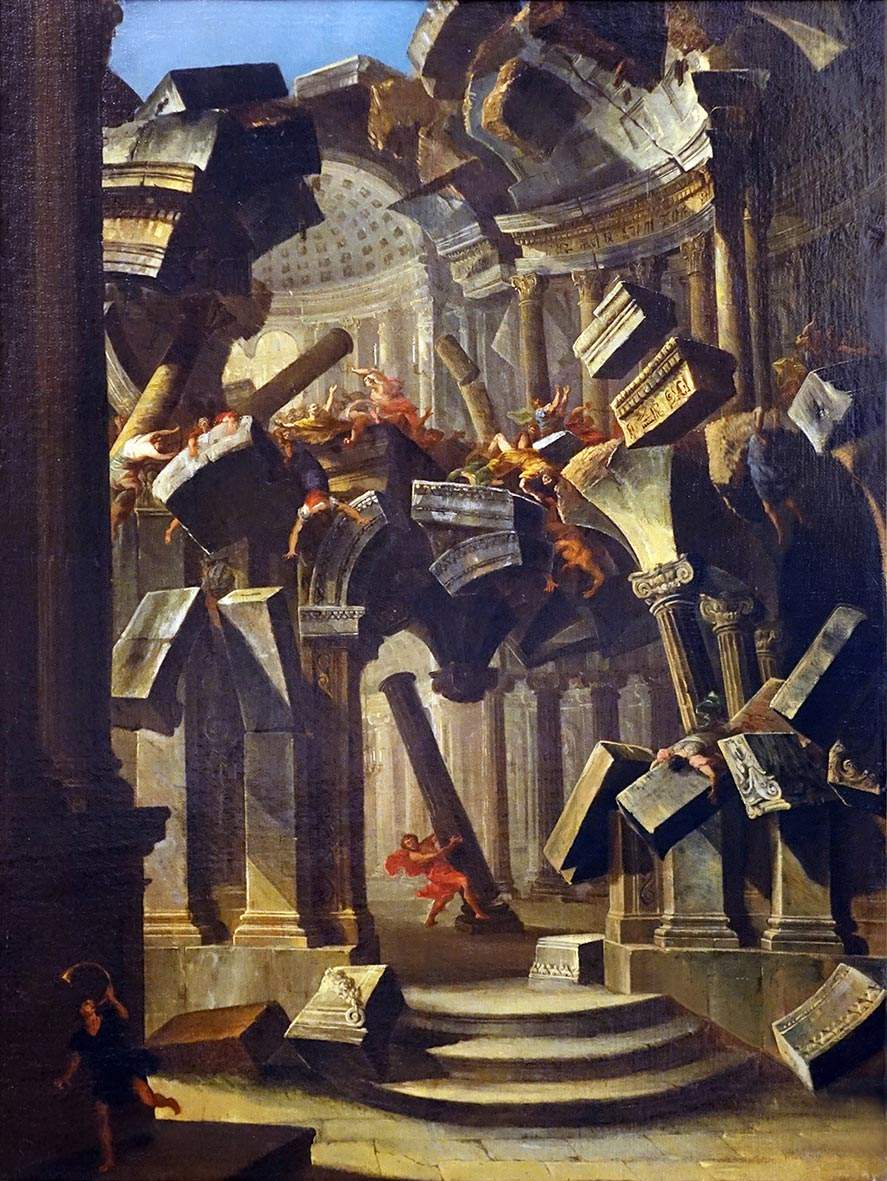From Sept. 18 to Nov. 8, 2020, BPER Banca ’s exhibition spaces in Modena will host the exhibition La prospettiva dell’epimero. Antonio Joli and the "scene for corner," an exhibition inaugurated on the occasion of festivalfilosophy 2020 that interprets the theme selected for the 20th edition of the festival(Machines) starting with a “scene for corner” by painter Antonio Joli (Modena, 1700 - Naples, 1777), part of the BPER Banca Collection. The work bears witness to the desire for “spectacularity” that characterized Baroque courts, not only in relation to scenic play, but also in a broader sense, in which the ideas of “artifice” and “wonder” responded to needs of occasional dynastic magnificence.
The exhibition, curated by Lucia Peruzzi, art historian and consultant to BPER Banca, makes use of an exhibition itinerary that begins with an oil-on-canvas work owned by BPER Banca, Samson Pulls Down the Temple, selected to delve into the painter’s early phase, characterized by a marked scenographic and theatrical intent, accounting for his early interests, oriented toward the genre of “architectural whimsy.” The painting is placed, therefore, in dialogue with two canvases by the same author, from the Museo Civico d’Arte in Modena: a second work entitled Samson Pulls Down the Temple and a painting dedicated to theBurning of Troy.
“These canvases, with their fascinating mixture of artifice and truth,” says the curator, “immerse us in the ephemeral and lively world of the theaters and stage design of the Este court in the early eighteenth century and send us back to those evocative ’stage appearances’ that were expertly followed during performances: ’large illuminated atriums, remote and ruined factories, ruined factories.’ Already in the previous century the pictorial specializations of quadraturism, ruinism and perspective scenography had established themselves in Modena with great success. In the early seventeenth-century Este city, which had recently risen to the rank of capital of the duchy, designers and scenographers, architects and well-known painters were employed, who, on occasion, tried their hand at daring inventions to offer the public astonishing artifices and satisfy the demands of a court aware of the importance of the message of art for the purposes of its own celebration. They came largely from nearby Bologna, the propelling center of the scenic and theatrical culture of the time, and produced very extensive decorative feats showing themselves capable also of creating scenic and festive apparatuses of an ephemeral nature: cars, carousels, tournaments, water games and ’fires of gaiety’.”
“The Emilian scenographic tradition,” Lucia Peruzzi continues, “received a decisive impulse, between the end of the seventeenth century and the beginning of the eighteenth century, with the adoption of the ’scene by corner’ by Ferdinando Galli Bibiena, completely innovative with respect to the traditional perspective constructions with a single central axis of Renaissance ancestry typical of Baroque theater. Antonio Joli’s early production fits into this cultural context. The works presented here, in the solution of the oblique cut of the view, in the motifs of balustrades and projecting balconies, denote a punctual reference to Bibienesque dictates. Undoubtedly, because of their strong evocation of theatrical machines and wings, they constitute transpositions of lost sets to be linked to musical works staged around 1725 on his return from Rome. Particularly in Samson, the beautiful invention of representing the collapse in action constitutes a very rare annotation of theatrical technique, the so-called ’diroccamento a vista,’ in which, a theatrical machine operated by means of complex maneuvers of ropes, weights and counterweights, instead of statically representing a pile of rubble, fixes the dynamics of the collapse at the very moment when the architecture is about to come crashing down with thunder on the stage.”
“For the first year,” says BPER Banca Chairman Pietro Ferrari, “BPER Banca is the main sponsor of the festival, and this confirms the concrete policy of supporting culture, in its various expressions, which has been underway for some time with numerous interventions that place alongside specific banking activities special attention to projects and initiatives of greater relevance coming from the communities served. The valuable collaboration with the Civic Museum of Art of Modena also confirms BPER Banca’s desire to create a network with the city’s institutions, which is fundamental especially at this time of recovery. This partnership, therefore, completes and enlivens a wide-ranging cultural collaboration project and constitutes, at the same time, an important new piece of our social responsibility activities. Facing uncertainty together is the key to ensuring a positive new beginning for the community, starting precisely with culture.”
The exhibition can be visited the first weekend of each month, Friday through Sunday, from 10 a.m. to 1 p.m. and 2 p.m. to 6 p.m. On the days of festivalfilosophy, the hours will be as follows: Friday, Sept. 18 and Sunday, Sept. 20, 10 a.m. to 6 p.m., Saturday, Sept. 19, 10 a.m. to 11 p.m. On Saturday, Oct. 3, during the “Invitation to the Palace” initiative, open 10 a.m. to 7 p.m. Guided tours, groups and special openings by appointment. The exhibition is free admission, with the requirement to wear personal protective equipment. Catalog available at the exhibition venue. For information: phone +39 059 2021598, email lagalleria@bper.it, website www.lagalleriabper.it.
Image: Antonio Joli Samson Felling the Temple (s.d.; oil on canvas, 97.5 x 73 cm; Modena, Collection of BPER Banca)
 |
| Antonio Joli's 18th-century perspectives are on display at BPER Bank in Modena |
Warning: the translation into English of the original Italian article was created using automatic tools. We undertake to review all articles, but we do not guarantee the total absence of inaccuracies in the translation due to the program. You can find the original by clicking on the ITA button. If you find any mistake,please contact us.